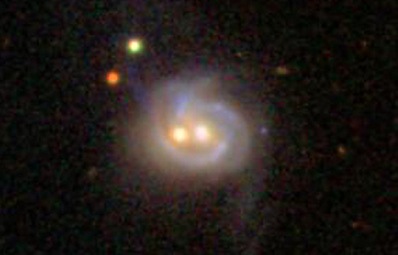
Galaxy boasts two monster black holes
DR EMILY BALDWIN
ASTRONOMY NOW
Posted: 14 June 2011


Using NASA's Swift satellite and the Chandra X-ray Observatory, astronomers have uncovered a second active black hole within galaxy NGC 3758.
The galaxy, which is also known by the name Markarian 739, lies 425 million light years away towards the constellation Leo, and the two active black holes – active galactic nuclei (AGN) – are separated by 11,000 light years. The majority of large galaxies, including our own Milky Way Galaxy, host supermassive black holes, but only about one percent of them are powerful AGN, and to find binary AGN is even rarer.

Viewed in visible light, Markarian 739 resembles a smiling face, with a pair of bright cores underscored by an arcing spiral arm. The object is really a pair of merging galaxies, and new data from Swift and Chandra reveal the western core (right) to be a previously unknown AGN, separated from its eastern counterpart by about 11,000 light-years. Image: SDSS.
Astronomers used Swift's Burst Alert Telescope (BAT) to map high energy X-ray sources within a distance of 650 million light years, leading to the identification of about a quarter of the AGN targets as interacting or set to merge. Zooming in with Chandra's X-ray telescope resolved the finer details.
Astronomers already knew that the eastern nucleus of Markarian 739 contained a black hole that is actively accreting matter but the new study revealed a similar monster in its western segment.
"It required X-ray observations to find it," Richard Mushotzky of the University of Maryland in College Park (UMCP) tells Astronomy Now. "The second nucleus, at least during the last two years when the optical spectra and UV data were obtained, shows no sign in these bands of being an AGN. It thus seems most likely that the second nucleus is 'invisible' in the optical and the UV."
AGN are likely switched on by galaxy collision and mergers. “If two galaxies collide and each possesses a supermassive black hole, there should be times when both black holes switch on as AGN,” says Mushotzky.
Markarian 739's double-eyed monster is the second-closest known example of a binary AGN – both in terms of distance from one another and distance from Earth. Galaxy NGC 6240 is the current record-holder, at 330 million light years distant, and with its AGN separated by just 3,000 light years.
Mushotzky adds that the team are working towards determining how prevalent binary AGN are throughout the Universe. "Three of our Chandra targets have not yet been observed and we are still obtaining optical spectra for a few of the possible binaries...so stay tuned!"
|



